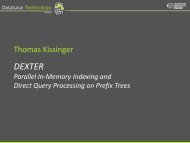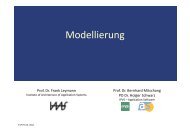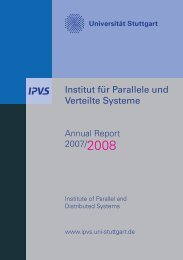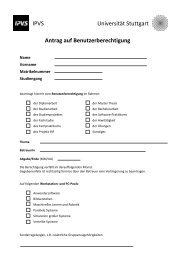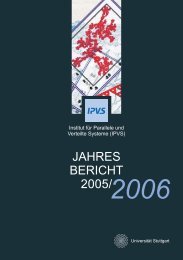Institut für Parallele und Verteilte Systeme - Universität Stuttgart
Institut für Parallele und Verteilte Systeme - Universität Stuttgart
Institut für Parallele und Verteilte Systeme - Universität Stuttgart
You also want an ePaper? Increase the reach of your titles
YUMPU automatically turns print PDFs into web optimized ePapers that Google loves.
22<br />
been enhanced by new constructed wheels and by the development of a new digital<br />
compass to improve the localization of the robot. Furthermore the adjustable electromagnetic<br />
kicker device was boosted to allow stronger ball shoots.<br />
One of the major soft ware topics in 2009 were the development of an accurate<br />
passing system which is able to adapt the passing behavior during the game, the improvement<br />
of learning algorithms to adapt the tactics and strategic behavior in realtime<br />
and also the optimization of the motor controller to improve the driving behavior.<br />
Furthermore to analyze a game in real-time an autonomous camera-agent was<br />
developed, which is driven only by communicated robot data in combination of a<br />
highly sophisticated 3D Visualization.<br />
Th e team won the German Open 2009 in Hanover and even during the world<br />
championship of Robocup in Graz (Austria), the 1.RFC-<strong>Stuttgart</strong> became new world<br />
champion 2009 in the the middle-size league. Furthermore the team achieved the 2nd<br />
place at the so-called “technical challenge” and a further 1st place at the “scientifi c<br />
challenge”.<br />
RoboEarth - Connecting Robots Worldwide<br />
RoboEarth is a world-wide platform which robots can use to exchange position and<br />
map information as well as task-related, hardware-independent action recipes. Th is will<br />
enable manufacturers worldwide to break down their costs and eff orts for reproducing<br />
soft ware algorithms for robot behavior over and over again. Th e RoboEarth framework<br />
can store all relevant data from algorithms to complex behavior descriptions that<br />
allows robots to act autonomously in an unknown, unspecifi ed environment. In 2009<br />
some literature surveys and fi rst approaches have been developed to create the general<br />
architecture of the so called recognition-/labeling-component, which will serve as the<br />
basic interface between the robot platforms and RoboEarth. Furthermore fi rst defi -<br />
nitions and agreements of<br />
the architecture of the centralized<br />
and platform independent<br />
web-based database<br />
system, which will<br />
be able to manage diff erent<br />
robotic relevant data,<br />
has been discussed and<br />
evaluated.



